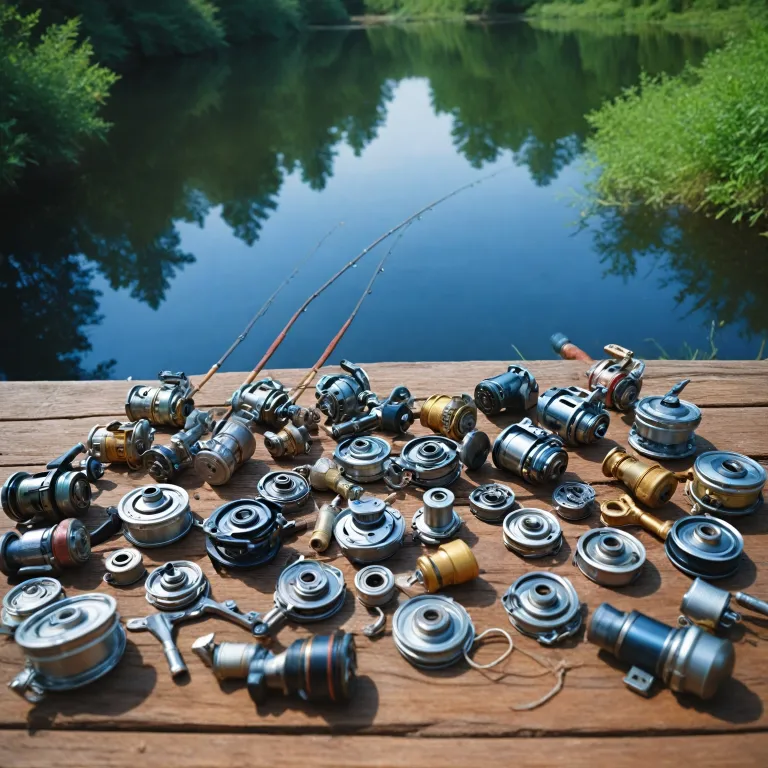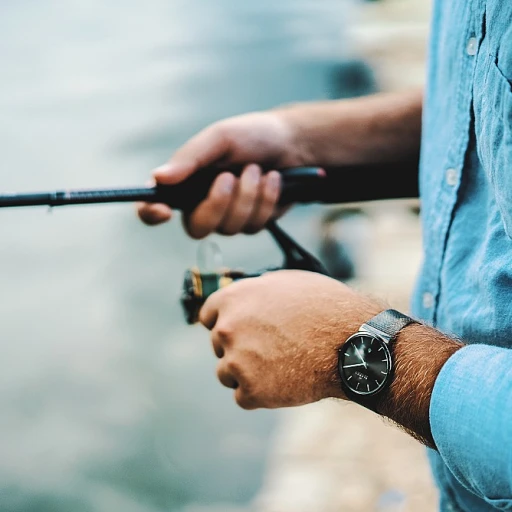
Understanding the importance of the reel handle
Why the Right Handle Matters in Fishing
When it comes to fishing, many anglers focus on the rod, line, or lure, but the reel handle is often overlooked. Yet, the handle is your direct connection to the fish and the power you need to control your reel. Whether you’re using a spinning reel or a baitcasting reel, the right handle can make a big difference in comfort, efficiency, and even your catch rate.
Handles come in various shapes and sizes, from the classic knob to the modern rotary knob or rocker arm. Each design impacts your grip, the speed of your retrieve, and how much power you can apply. For example, a power handle or a metal rocker arm can give you more leverage when fighting bigger fish, while a lightweight carbon fiber handle might reduce fatigue during long sessions.
- Grip and comfort: The handle grip and knob design affect how secure and comfortable your hold is, especially during wet conditions or when using heavier reels.
- Material: Handles made from metal, carbon fiber, or composite materials each have their own pros and cons regarding durability, weight, and price.
- Replacement and upgrades: Many products, like Daiwa or Gomexus, offer replacement handle options, allowing you to customize your reel for better performance or style.
Choosing the right reel handle isn’t just about looks or brand. It’s about matching your handle to your fishing style, target species, and the specific demands of your reel—whether it’s a spinning reel or baitcasting reel. If you’re planning your next fishing adventure, understanding how the handle fits into your overall setup is just as important as picking the right rod. For more tips on choosing gear for your trips, check out this guide on travel fishing rods.
In the next sections, we’ll look at how different materials impact performance, what to look for in grip and ergonomics, and how to maintain and upgrade your reel handles for the best fishing experience.
Materials used in reel handles and their impact
Comparing Popular Reel Handle Materials
When it comes to reel handles, the material you choose can make a big difference in your fishing experience. The handle is not just a simple accessory; it affects grip, comfort, power, and even the overall weight of your reel. Here’s a breakdown of the most common materials used in reel handles and how they impact performance and price.
- Aluminum: Known for its durability and strength, aluminum is a popular choice for both spinning and baitcasting reels. It offers a solid feel and good power transfer, making it ideal for anglers who need a robust handle for larger catches. However, aluminum handles can add weight to your setup, which might be a concern for those who prioritize speed and lightweight gear.
- Carbon Fiber: If you’re looking for a lightweight option without sacrificing strength, carbon fiber handles are worth considering. They provide excellent rigidity and reduce overall reel weight, which can help with fatigue during long fishing sessions. The price is usually higher, but many anglers find the investment worthwhile for the added comfort and performance.
- Stainless Steel: Stainless steel handles are highly resistant to corrosion, making them a solid choice for saltwater fishing. They offer a balance between strength and weight, but can sometimes feel colder or less comfortable in the hand compared to other materials.
- Plastic and Composite: These materials are often found in entry-level reels due to their lower price. While they keep the reel light, they may not offer the same durability or power as metal or carbon fiber options. For occasional or light fishing, they can be sufficient, but serious anglers may want to look for an upgrade.
How Material Affects Grip and Knob Options
The material of your handle also influences the type of grip and knob you can use. For example, a metal rocker arm or carbon fiber handle often pairs well with a rotary knob or ergonomic arm grip, providing better control and comfort. Some brands, like Daiwa and Gomexus, offer a range of replacement handle options, including power handles and specialized knobs designed for specific fishing styles.
Considering Maintenance and Longevity
Material choice impacts not only performance but also maintenance. Metal handles, especially those made from aluminum or stainless steel, require regular cleaning to prevent corrosion, especially in saltwater environments. Carbon fiber and composite handles are generally easier to maintain but can be more susceptible to impact damage if not handled carefully. If you’re thinking about a handle replacement or upgrading to a replacement power handle, consider how much time you want to spend on maintenance versus fishing.
Finding the Right Balance for Your Needs
Ultimately, the best reel handle material depends on your fishing style, target species, and budget. Whether you’re looking for a lightweight spinning reel handle, a sturdy baitcasting reel arm, or a comfortable grip fishing knob, there are plenty of options to suit your needs. For a deeper dive into innovative fishing gear, check out this guide to Santos fishing gear for more insights on the latest product trends and replacement options.
Ergonomics and grip: what to look for
How Ergonomics and Grip Influence Your Fishing Experience
When it comes to choosing a reel handle, ergonomics and grip are often underestimated. Yet, these factors can make or break your fishing session, especially during long hours on the water. The right handle grip ensures comfort, reduces fatigue, and gives you better control over your spinning or baitcasting reel. Whether you’re using a carbon fiber handle or a metal rocker arm, the design and feel of the grip matter just as much as the material itself.
- Knob Shape and Size: A larger rotary knob or power handle provides more leverage, which is crucial for fighting bigger fish. Smaller knobs may be lighter but can cause discomfort over time.
- Grip Texture: Look for a handle grip with non-slip surfaces. Textured or rubberized grips help maintain control, even when your hands are wet or cold.
- Arm Length: The length of the handle arm affects both speed and power. A longer arm gives you more torque, while a shorter arm is better for quick retrieves. Consider your fishing style and the type of reel—spinning or baitcasting—when evaluating arm grip options.
- Handle Replacement Options: Many anglers upgrade to aftermarket handles like Gomexus or Daiwa for improved ergonomics. These replacement handles often feature advanced designs for better comfort and performance.
Don’t overlook the importance of a comfortable grip when comparing price and product features. A well-designed handle knob can be the difference between a successful day and one cut short by hand fatigue. If you’re unsure about which handle suits your needs, try different options or read product reviews that focus on grip fishing and ergonomics.
For anglers interested in optimizing every part of their setup, understanding how handle ergonomics interact with other tackle—like choosing the right 1 oz jig heads—can further enhance your fishing experience.
Maintenance tips for your reel handle
Keeping Your Reel Handle in Top Shape
Regular maintenance of your reel handle is essential for smooth fishing experiences and to extend the life of your gear. Whether you use a spinning reel, baitcasting reel, or a power handle, neglecting basic care can lead to issues with grip, performance, and even the price of future replacements.- Clean After Every Trip: Salt, sand, and dirt can easily get into the handle knob, rotary knob, and arm grip. Rinse your reel handles with fresh water after each outing, especially if you fish in saltwater. Dry thoroughly to prevent corrosion, especially on metal rocker arms and carbon fiber components.
- Lubricate Moving Parts: The connection between the handle and the reel body, as well as the rotary knob, should be lubricated periodically. Use a light reel oil or grease designed for fishing products. This keeps the action smooth and prevents wear on the handle metal and internal gears.
- Inspect for Wear: Check the grip fishing surfaces and the handle knob for signs of cracking, excessive wear, or looseness. If you notice wobbling or reduced power when cranking, it may be time for a replacement handle or a new arm grip.
- Tighten Screws and Fittings: Over time, the screws securing the handle, rocker arm, and knob can loosen. Use the correct tool to check and tighten these parts before each trip. This is especially important for high-speed reels and power handle setups.
- Store Properly: When not in use, store your reels in a dry place. Avoid leaving them in direct sunlight or damp environments, which can degrade both metal and carbon fiber handle materials.
Upgrading your reel handle: when and why
When to Consider a Reel Handle Upgrade
Upgrading your reel handle can make a noticeable difference in your fishing experience. If you find your current handle uncomfortable, lacking in grip, or not providing enough power, it might be time for a replacement. Many anglers switch to a power handle or a larger rotary knob when targeting bigger species or when using heavy-duty baitcasting reels. These options offer more leverage and control, especially during long fights.
Why Upgrade? Key Benefits
- Improved Grip and Comfort: Modern handle grips, such as those made from carbon fiber or ergonomic rubber, reduce hand fatigue and improve control during extended fishing sessions.
- Enhanced Power: A power handle or metal rocker arm provides more torque, making it easier to reel in strong fish. This is especially useful for spinning reels and baitcasting reels used in saltwater or for larger freshwater species.
- Customization: Upgrading allows you to choose a handle knob or arm grip that matches your style and needs, whether you prefer a lightweight carbon fiber handle or a sturdy metal rocker.
- Replacement for Worn Parts: Over time, the original handle or knob may wear out or become loose. A replacement handle or knob restores the reel’s performance and reliability.
- Style and Brand Matching: Many anglers like to match their handles with their favorite brands, such as Daiwa or Gomexus, or to coordinate the look of their gear.
Popular Handle Upgrade Options
| Handle Type | Material | Best For | Price Range |
|---|---|---|---|
| Power Handle | Metal, Carbon Fiber | Heavy-duty fishing, big game | $$–$$$ |
| Rocker Arm | Aluminum, Stainless Steel | Saltwater, spinning reels | $$ |
| Rotary Knob | EVA, Rubber, Metal | Comfort, all-day fishing | $–$$ |
| Carbon Fiber Handle | Carbon Fiber | Lightweight, finesse fishing | $$$ |
How to Choose the Right Replacement
When selecting a replacement handle, check compatibility with your reel model. Brands like Daiwa and Gomexus offer a range of handle replacements for both spinning and baitcasting reels. Consider the handle grip material, knob size, and arm length to match your fishing style. If you need more speed, a longer arm or larger knob can help you retrieve line faster. For more power, look for a robust metal rocker or power handle.
Remember, the right upgrade can turn a good fishing reel into a great one, enhancing both comfort and performance on the water.
Common mistakes to avoid when selecting a reel handle
Overlooking Key Factors When Picking a Reel Handle
Many anglers make avoidable mistakes when selecting a new reel handle or considering a replacement. These errors can affect comfort, performance, and even the longevity of your fishing reel. Here are some of the most common pitfalls and how to steer clear of them:
- Ignoring Compatibility: Not all handles fit every reel. Whether you use a spinning reel, baitcasting reel, or a specialized power handle, always check if the handle or knob is compatible with your specific model. Brands like Daiwa or Gomexus often have unique fitting requirements. Double-check the product specifications before buying a replacement handle.
- Prioritizing Price Over Quality: It’s tempting to go for the cheapest option, but a low-cost handle made from inferior materials can compromise grip, durability, and even the power you can apply. Consider investing in a handle metal or carbon fiber arm for better longevity and performance.
- Neglecting Ergonomics: A handle that looks good may not always feel good in your hand. Failing to test the grip or rotary knob comfort can lead to fatigue or blisters during long fishing sessions. Look for a handle grip or arm grip that matches your fishing style and hand size.
- Overlooking Maintenance Needs: Some anglers forget that certain materials, like metal rocker arms or carbon fiber, require specific care. Not maintaining your reel handle can lead to corrosion or a stiff rocker, reducing the smoothness and speed of your retrieve.
- Misjudging Power and Speed Needs: Choosing a handle based on looks rather than function can impact your fishing. For example, a power handle is ideal for heavy-duty fishing, while a smaller knob or arm is better for finesse techniques. Match the handle to your target species and fishing technique.
- Ignoring Replacement Options: Sometimes, anglers stick with the original handle even when a replacement handle or knob could improve their experience. Explore aftermarket options, like Gomexus or other reputable brands, for a better fit or upgraded features.
By keeping these points in mind, you’ll avoid the most common mistakes and ensure your handle fishing setup is both comfortable and effective. Whether you’re looking for a handle replacement, a new arm grip, or a rotary knob, making informed choices leads to a better fishing experience overall.



-large-teaser.webp)









